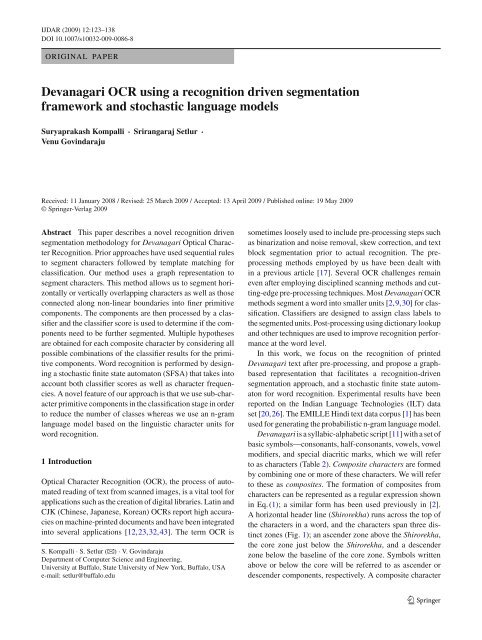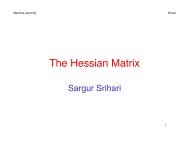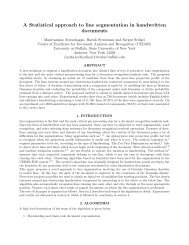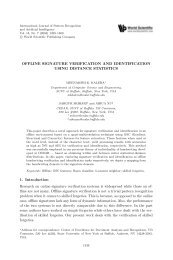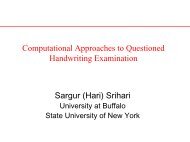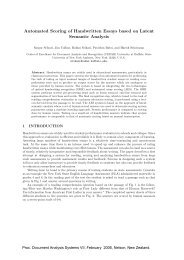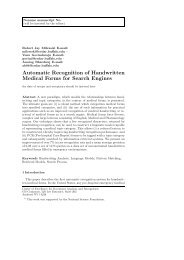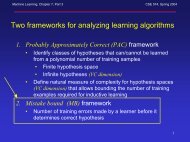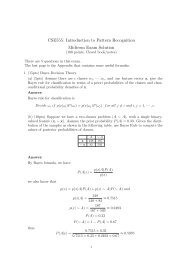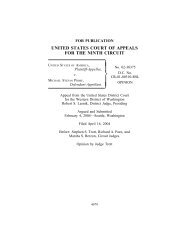Devanagari OCR using a recognition driven segmentation ...
Devanagari OCR using a recognition driven segmentation ...
Devanagari OCR using a recognition driven segmentation ...
Create successful ePaper yourself
Turn your PDF publications into a flip-book with our unique Google optimized e-Paper software.
IJDAR (2009) 12:123–138DOI 10.1007/s10032-009-0086-8ORIGINAL PAPER<strong>Devanagari</strong> <strong>OCR</strong> <strong>using</strong> a <strong>recognition</strong> <strong>driven</strong> <strong>segmentation</strong>framework and stochastic language modelsSuryaprakash Kompalli · Srirangaraj Setlur ·Venu GovindarajuReceived: 11 January 2008 / Revised: 25 March 2009 / Accepted: 13 April 2009 / Published online: 19 May 2009© Springer-Verlag 2009Abstract This paper describes a novel <strong>recognition</strong> <strong>driven</strong><strong>segmentation</strong> methodology for <strong>Devanagari</strong> Optical CharacterRecognition. Prior approaches have used sequential rulesto segment characters followed by template matching forclassification. Our method uses a graph representation tosegment characters. This method allows us to segment horizontallyor vertically overlapping characters as well as thoseconnected along non-linear boundaries into finer primitivecomponents. The components are then processed by a classifierand the classifier score is used to determine if the componentsneed to be further segmented. Multiple hypothesesare obtained for each composite character by considering allpossible combinations of the classifier results for the primitivecomponents. Word <strong>recognition</strong> is performed by designinga stochastic finite state automaton (SFSA) that takes intoaccount both classifier scores as well as character frequencies.A novel feature of our approach is that we use sub-characterprimitive components in the classification stage in orderto reduce the number of classes whereas we use an n-gramlanguage model based on the linguistic character units forword <strong>recognition</strong>.1 IntroductionOptical Character Recognition (<strong>OCR</strong>), the process of automatedreading of text from scanned images, is a vital tool forapplications such as the creation of digital libraries. Latin andCJK (Chinese, Japanese, Korean) <strong>OCR</strong>s report high accuracieson machine-printed documents and have been integratedinto several applications [12,23,32,43]. The term <strong>OCR</strong> isS. Kompalli · S. Setlur (B) · V. GovindarajuDepartment of Computer Science and Engineering,University at Buffalo, State University of New York, Buffalo, USAe-mail: setlur@buffalo.edusometimes loosely used to include pre-processing steps suchas binarization and noise removal, skew correction, and textblock <strong>segmentation</strong> prior to actual <strong>recognition</strong>. The preprocessingmethods employed by us have been dealt within a previous article [17]. Several <strong>OCR</strong> challenges remaineven after employing disciplined scanning methods and cutting-edgepre-processing techniques. Most <strong>Devanagari</strong> <strong>OCR</strong>methods segment a word into smaller units [2,9,30] for classification.Classifiers are designed to assign class labels tothe segmented units. Post-processing <strong>using</strong> dictionary lookupand other techniques are used to improve <strong>recognition</strong> performanceat the word level.In this work, we focus on the <strong>recognition</strong> of printed<strong>Devanagari</strong> text after pre-processing, and propose a graphbasedrepresentation that facilitates a <strong>recognition</strong>-<strong>driven</strong><strong>segmentation</strong> approach, and a stochastic finite state automatonfor word <strong>recognition</strong>. Experimental results have beenreported on the Indian Language Technologies (ILT) dataset [20,26]. The EMILLE Hindi text data corpus [1] has beenused for generating the probabilistic n-gram language model.<strong>Devanagari</strong> is a syllabic-alphabetic script [11] with a set ofbasic symbols—consonants, half-consonants, vowels, vowelmodifiers, and special diacritic marks, which we will referto as characters (Table 2). Composite characters are formedby combining one or more of these characters. We will referto these as composites. The formation of composites fromcharacters can be represented as a regular expression shownin Eq. (1); a similar form has been used previously in [2].A horizontal header line (Shirorekha) runs across the top ofthe characters in a word, and the characters span three distinctzones (Fig. 1); an ascender zone above the Shirorekha,the core zone just below the Shirorekha, and a descenderzone below the baseline of the core zone. Symbols writtenabove or below the core will be referred to as ascender ordescender components, respectively. A composite character123
124 S. Kompalli et al.Fig. 1 Character zones in a <strong>Devanagari</strong> word (top) and nomenclatureused for sub-elements of a word (bottom)formed by one or more half consonants followed by a consonantand a vowel modifier will be referred to as a conjunctcharacter or conjunct. Further, we use the followingnomenclature for composite characters to indicate modifierlocation: Consonant–vowel (independent consonant or vowelwith no ascenders or descenders), consonant–ascender (consonantwith ascender), consonant–descender (consonant withdescender), conjunct–core (conjunct with no ascenders ordescenders), conjunct–ascender, and conjunct–descender.Composite character → V |(c ∗ C[υ][s])where V -VowelC - Consonantc - Half-consonantv - Vowel modifiers - Special accents<strong>Devanagari</strong> word → (Composite character) +1.1 Prior work in <strong>segmentation</strong>Removal of the shirorekha is a frequently used technique tosplit words into composites [9,38]. Classification at the compositecharacter level is very challenging as the number ofvalid classes exceeds 5,000. The ILT image data set [20,26]has 10,606 word images containing 973 composite characterclasses, and the EMILLE text data set [1] has 5,573 compositecharacter classes. Some sample images from the ILT dataset are shown in Fig. 3. Typically, the difficulty of designing aclassifier increases with the size of the class space, and findingsufficient samples of all classes for training becomes acritical problem. For example, 537 composite character classesfrom the ILT data set occur less than 25 times each. Sincethe number of such poorly represented classes is very large,<strong>OCR</strong> results are adversely affected.An alternative approach [2,17,30] is to further segmentthe composite characters into smaller parts, which wewill refer to as components. The class space of componentsis significantly smaller than that of composite characters.For example, the 11 composite characters in the set(1)are formed bycombining 8 characters:, and thesein turn are formed from the following 5 components:. While there is some variation in the shapeand location of components from one font to another, thebasic shape and position of components remains fairly consistent.e.g: The vowel modifier has an ascender part thatalways occurs above the shirorekha, and a part that occursin the core region ; However, minor variations in thesecomponents can be seen in the examples in Fig. 2(b).The position of components may be estimated <strong>using</strong>structural attributes such as location and number of verticalstrokes, average size, and aspect ratio. Structural informationcan be extracted from a paragraph or line of text, or basedon knowledge of the font. However, font variations and poorprint quality cause structural features to vary across wordsin the same line [24] (Fig. 2a, b). We show that it is possibleto use a graph representation of a word image to capturethe basic positions of components and also enable <strong>segmentation</strong>of composites. Structural information from paragraphs,lines, or a priori font data is not required to compute the graphrepresentation.Our work is partly inspired by the paradigm of <strong>recognition</strong>-<strong>driven</strong><strong>OCR</strong>, originally proposed by Casey et al. [8].<strong>Devanagari</strong> <strong>OCR</strong> methods reported in the literature [4] followa dissection technique; a word is segmented into smallerparts, and classifiers are employed to assign class labels to thesegmented image pieces. There is no feedback loop to correcterroneous <strong>segmentation</strong>. We design a stochastic frameworkthat is used to prune multiple <strong>segmentation</strong> hypotheses.Sliding window with forepart prediction has been extensivelyused in multi-font Latin <strong>OCR</strong> to separate fusedcharacters [41]. A linear <strong>segmentation</strong> window is employed.Classifiers are used to map the two segmented parts to Latincharacters. If the segmented parts produce classifier resultswith confidence less than a threshold, that <strong>segmentation</strong>hypothesis is rejected and the next hypothesis is considered.Linear windows sliding in only one direction do not workwell with <strong>Devanagari</strong> script where composites need to besegmented along non-linear boundaries in two directions:left to right and top to bottom (Fig. 2c).Lee et al. [29] outline a technique wherein they constructa graph by treating pixels of a gray-scale image as nodes thatcan be traversed to obtain <strong>segmentation</strong> hypotheses. Whilethis method can trace a non-linear boundary, it leads to a largenumber of <strong>segmentation</strong> hypotheses.1.2 Prior work in language modeling<strong>Devanagari</strong> character formation can be said to be governedby a set of script composition rules [37]: e.g. Vowelmodifiers should be associated with a consonant, only onevowel modifier must be present in a character. <strong>OCR</strong>s can123
<strong>Devanagari</strong> <strong>OCR</strong> <strong>using</strong> <strong>recognition</strong> <strong>driven</strong> <strong>segmentation</strong> and stochastic language models 125Fig. 2 <strong>Devanagari</strong> text samples: a descenders, b fused characters and stylized fonts, c composite characters, d fragmented conjunctsFig. 3 Sample images from the ILT data settake advantage of these rules to improve performance [2,30].Dictionary lookup has been used as a post-processing stepby Bansal et al. [3] to prune word <strong>recognition</strong> results. Use ofprobabilistic models which can enhance <strong>recognition</strong> resultsbefore <strong>using</strong> dictionary lookup have not been reported in the<strong>Devanagari</strong> <strong>OCR</strong> literature. Examples of such probabilisticmodels include alphabet n-grams which have been used inLatin <strong>OCR</strong> [7,19], and word n-grams and trigger pairs whichhave been used in speech <strong>recognition</strong> systems [35]. Most ofthese probabilistic language models have used characters orwords as units of the language model. At the sub-word level,attempts have been made to design models based on morphemes,or suffix-prefix relations [18,39]. Readers shouldrefer to Kukich [27] for an excellent survey of some of thesetechniques.Sections 2.1 and 2.2 describe our <strong>recognition</strong> <strong>driven</strong> approachfor <strong>segmentation</strong> and generation of multiple componenthypotheses. Section 2.3 describes the design of a StochasticFinite Automata (SFSA) that outputs word <strong>recognition</strong>results based on the component hypotheses and n-gram statistics.Section 2.4 describes the design of a language modelbased on the linguistic composite character units. Section 3presents our experimental results with analysis. Section 4outlines future work.2 Proposed <strong>segmentation</strong> methodologyLet us define a graph representation G of a word or a characterimage I ,derivedfromatopologicalrepresentation[42](Eq.2).G = (N, E)whereN ={N i } (Nodes, or Vertices)E ={E ij } (Undirected edges)E ij { 1 if there is an edge between N i, N j0 otherwisei, j = 1, 2,...,|N|I = I 1 ∪ I 2 ···∪ I |N|I i ∩ I j =∅,ifi ̸= jEach graph G consists of a set of nodes N and a set ofedges E. Each image I is divided into a number of horizontalruns(Hruns). Each of these runs are classified as merging,splitting or continuing runs based on the number of Hrunsin the row immediately above it (abv) or in the row immediatelybelow (bel) it. In splitting Hruns, abv ≤ 1 and bel > 1and in merging Hruns, abv >1 and bel ≤ 1. The remainingHruns are classified as continuing. Adjacent runs whichare classified as continuing are merged into a single block.(2)123
126 S. Kompalli et al.A splitting Hrun is added to the block that occurs above it anda merging Hrun is added to the block that occurs below it. Agraph can be constructed by connecting the centroids of theneighboring blocks. A group of the continuing runs is definedas an image segment I i or block. A node N i of the graph Grepresents the center of mass of the image segment I i .Wedefine an edge E ij when the corresponding nodes N i , N j areconnected.Variants of such a graph representation have been used informs processing applications for form frame detection [46]and to extract features like loops, cusps, joints for classificationin Chinese and Latin script <strong>recognition</strong> [34,45,47].Figure 4 illustrates the process of generating a blockadjacency graph (BAG) from a character image, and Fig. 5ashows the BAG generated from a word image.After the BAG is constructed from a word image, baselinesare computed <strong>using</strong> linear regression [40]. Blocks that lieparallel to the baseline and have a large aspect ratio and areagreater than three times the average stroke width are identifiedas the shirorekha s. Blocks above the shirorekha corre-Fig. 4 Obtaining block adjacency graph. a Using horizontal runs(HRUNS) to identify initial blocks, b removing noisy HRUNS andcreating blocksspond to ascenders a, and the remaining blocks correspond tocore components c. Since the shirorekha is very prominent,gross labeling of s, a, c is trivial even in noisy <strong>Devanagari</strong>words. The core components can be isolated characters thatdo not require further <strong>segmentation</strong> or conjunct and fusedcharacters that may or may not have descenders. A <strong>recognition</strong><strong>driven</strong> <strong>segmentation</strong> paradigm <strong>using</strong> graph featuresand classifiers is used to segment the conjuncts and fusedcharacters.Fig. 5 Using block adjacency graphs (BAG) for <strong>Devanagari</strong> <strong>OCR</strong>.a Obtaining BAG from a word image; left original image, center BAGstructure showing nodes, right edges between the nodes superimposedover the word image. b Left Edges selected for <strong>segmentation</strong> are shownin dotted lines; identification of shirorekha (1) and ascender (4), centerpreliminary <strong>segmentation</strong> hypothesis showing nodes for each segment,right corresponding image segments. c Splitting a conjunct core component.Columns 1, 2 Nodes of the graph selected as <strong>segmentation</strong>hypotheses, column 3 image segments corresponding to the nodes, column4 classifier results for each image segment in column 3. d Latticeof classifier hypotheses. Results in circles are the correct class labels123
<strong>Devanagari</strong> <strong>OCR</strong> <strong>using</strong> <strong>recognition</strong> <strong>driven</strong> <strong>segmentation</strong> and stochastic language models 1272.1 Segmentation <strong>using</strong> graphsWe perform <strong>segmentation</strong> by selecting subgraphs from theBAG representation of word or character images. A subgraphselected is a group of nodes from the BAG G andthe ideal selection of sub-graphs will segment the image intoits constituent <strong>Devanagari</strong> components. A naive approach isto exhaustively segment sub-graphs from the BAG. Such ascheme is computationally inefficient, since the number ofpossible hypotheses grows exponentially. The search spaceof hypotheses is pruned <strong>using</strong> the following constraints: (i)The primitives in the class space are assumed to be joinedfrom left to right or top to bottom, and (ii) all of the primitivesare assumed to consist of a single connected component. Theequivalent conditions for sub-graph selection are: (i) A nodecannot be selected if it is to the right (bottom for descendercharacters) of a node that has not been selected; and (ii)sub-graphs cannot have disconnected nodes. Using the graphrepresentation, we can segment a composite character alongcurves, splits, and merges in the word image. The methodgenerates fewer <strong>segmentation</strong> hypotheses than the windowbased approaches reported in literature [29,41]. Once thesubgraphs have been extracted, they can be mapped back tothe associated image segments thereby generating <strong>segmentation</strong>hypotheses. Images corresponding to the subgraphsare then input to a classifier (Sect. 2.2). Figure 5c shows anexample of how different subgraphs can be selected fromG to obtain <strong>segmentation</strong> hypotheses. Using the constraintsdescribed, the number of hypotheses can be further reduced.2.2 Recognition <strong>driven</strong> <strong>segmentation</strong>The use of classifiers to limit <strong>segmentation</strong> results has beenused in Latin <strong>OCR</strong> [8,28]. We adopt a similar strategy for<strong>Devanagari</strong>. Table 1 shows the 71 component shapes thatTable 1 Class space of our system (components)form our class space. There are 6 ascender shapes (a), 5descender shapes (d) and 60 other core component shapes(c). For each subgraph extracted from the BAG of the wordor character image, we input the corresponding subgraphimage to a classifier. A score from the classifier below thethreshold is taken as an indication that the input <strong>segmentation</strong>hypothesis does not correspond to one of the known classes.Procedure 1 outlines the specific steps used in our approach.Procedure 1 Segment(G)1: for all Word images w ∈ W do2: Start processing w3: Obtain Block adjacency graph BAG(w) from w4: Remove Shirorekha and detect baseline <strong>using</strong> BAG(w)5: Generate multiple <strong>segmentation</strong> hypothesis H ={h 1 , h 2 , h 3 , ...,h k } from BAG(w) via subgraph selection6: for all Segmentation hypothesis h i ∈ H do7: if h i represents an Ascender then8: Classify and remove ascender9: else10: Classify as core components11: if Classifier score > Threshold score obtained from ROCanalysis then12: Call procedure RECOGNIZE(h i )13: else14: if Character crossed baseline then15: Segment character from top to bottom16: else17: Segment character from left to right18: end if19: Call procedure RECOGNIZE(h i )20: end if21: end if22: end for23: end for2.2.1 ClassifiersClassifiers are used to assign a class label from the classspace for each input image and several classifier designshave emerged over the years. We have implemented previouslyknown feature extraction techniques and applied themto <strong>Devanagari</strong> component classification. The features usedin the experiments are gradient, structural and concavity featuresthat are scale invariant and the classifiers are based onneural networks, or K-nearest neighbor. The classifiers canbe considered as a function score(I, C) where I is the inputimage, and C is the class space. The result S is of theformat: 〈o h1 , s h1 〉, 〈o h2 , s h2 〉···〈o hi , s hi 〉, where o hi is theoutput class and s hi ⇒ R represents the class score or classconditionalprobability obtained from the classifier.1. Neural network classifier <strong>using</strong> Gradient features Thisclassifier has 72 input nodes, 48 hidden nodes and 40output nodes and uses the gradient sub-set of the GSC featureset. The GSC feature set was originally introduced forLatin handwriting <strong>recognition</strong> in [14]. The top-choice123
128 S. Kompalli et al.Procedure 2 Recognize(h)1: Initialize result set to return: R ={}2: Represent each hypothesis h as a tuple < h 1 , h 2 >3: Extract image I h1 and I h2 corresponding to hypothesis tuple< h 1 , h 2 >4: for all < h 1 , h 2 > do5: if conjunct-core then6: S h1 = score(I h1 ,valid core component)7: S h2 = score(I h2 ,valid core component)8: R ={R,< S h1 , S h2 >}9: end if10: if consonant-descender then11: S h1 = score(I h1 ,valid core component)12: S h2 = score(I h2 ,valid descender component)13: R ={R,< S h1 , S h2 >}14: end if15: if conjunct-descender then16: S h2 = score(I h2 ,valid descender component)17: R ={}, conjunct − core18: Get <strong>recognition</strong> result for image I h1 by callingRECOGNIZE(h 1 )19: for all < h 11 , h 12 > do20: R ={R,}21: end for22: end if23: end forclassifier accuracy on isolated consonant images is94.36%2. Neural network classifier <strong>using</strong> GSC features This classifierhas 512 input nodes, 128 hidden nodes and 40 outputnodes and uses the GSC feature set. The top-choice classifieraccuracy on isolated consonant images is 95.25%.3. K-nearest neighbor classifier <strong>using</strong> GSC features This isa K-nearest neighbor classifier that uses the GSC feature setand the Kulzinsky metric. This classifier has been previouslyused for handwriting <strong>recognition</strong> for Latin script [44]. Weexamined different values of K before selecting K = 3, whichgave a top choice accuracy of 94.27% on isolated consonantimages.Both the neural networks are fully connected, and uselogistic activation function. The neural networks have beentrained <strong>using</strong> standard back-propagation. We retain the top3 results returned by each classifier. The output scores forboth the neural network as well as the K-nearest neighborclassifier range from 0.0 to 1.0. Receiver operator characteristicsare analyzed and the equal error rate is selected asthe threshold score for each class. Low thresholds increasethe number of false positives (Conjuncts and descenders areaccepted and under-<strong>segmentation</strong> occurs) and high thresholdsincrease false rejects (Consonants/vowels are rejectedand over-<strong>segmentation</strong> occurs). The neural network classifierwith GSC features provides the best result amongst thethree methods.The character <strong>recognition</strong> results from this stage are ofthe form: O h ={o h1 s h1 , o h2 s h2 , ..., o hk s hk }, where o and srepresent the output class label and the associated confidencescore from the classifier. In cases where each hypothesis h irepresents a core component fused with another component(e.g. a conjunct character), the output is returned in the formof a tuple 〈o hi 1s hi 1, o hi 2s hi 2〉 where h i1 is the first part ofthe fused component and h i2 is the second part. In case ofascenders, only one hypothesis is obtained. For example, theresults from the image shown in Fig. 5d can be written asfollows:A probabilistic finite state automata is used to processthese core, descender and ascender component hypothesesand generate word-level results.2.3 Finite state automata to generate wordsThe <strong>recognition</strong> <strong>driven</strong> <strong>segmentation</strong> based on the BAG structuregenerates multiple hypotheses for each composite orfused character. While many words may be formed by combiningthese component results, not all of them are equallylikely or valid. Script composition rules and corpus-basedprobabilistic language models can be used to eliminate invalidchoices and rank the word results. We design a StochasticFinite State Automata (SFSA) to combine the rule basedscript composition validity checking and a probabilisticn-gram language model into a single framework. We comparethe use of various linguistic modeling units in selectingthe n-grams.The general idea in designing a SFSA is to create a Finite-State Machine (FSM) that accepts strings from a particularlanguage, and assigning data-<strong>driven</strong> probabilities to transitionsbetween states. If a candidate word is accepted, a scoreor probability is obtained and if rejected, corrections can bemade <strong>using</strong> the minimum set of transitions that could not betraversed [21]. SFSA has been previously used to generatepredictive text for hand-held devices [15], and to model errorcorrecting parsers [22]. In both applications, the SFSA is builtby studying n-grams <strong>using</strong> suffix/prefix relations in Englishtext. SFSA has also been used in handwriting <strong>recognition</strong> tomodel the relation between image features like loops, cusps,or lines and the underlying alphabets and words [45]. In ourmethodology, the SFSA is modeled <strong>using</strong> script compositionrules, and the transition probabilities are modeled on characteror composite character n-grams. Some of the rules encodepositional properties of components. For instance, descendercomponents are placed below a core component (e.g. themodifier is written below to form: ), or the vowelmodifier is made of the component written on top of123
<strong>Devanagari</strong> <strong>OCR</strong> <strong>using</strong> <strong>recognition</strong> <strong>driven</strong> <strong>segmentation</strong> and stochastic language models 129Table 2 Decomposition of <strong>Devanagari</strong> characters into primitive components for <strong>recognition</strong>. The edges E of our graph representation (Eq. 2) inherentlyencode the connectivity between components. The <strong>recognition</strong><strong>driven</strong> <strong>segmentation</strong> outlined in Procedure 1 translatesthis information into a sequence of class labels; Forinstance the class label sequence for and are:and respectively. Due to this inherent ordering presentin class labels, positional information is not specifiedexplicitly in our implementation of script composition rules.Equation 1 represents a context sensitive grammar thatdescribes the formation of valid <strong>Devanagari</strong> characters, andTable 2 describes the decomposition of characters into theirsub-character primitives (components).The SFSA is defined as follows: λ = (Q, O, I, F, A,Σ,δ), where– Q : states– O : observations (72 component classes, Table 1)123
130 S. Kompalli et al.– I : initial states, which indicate start of a character– F: final states, which indicate end of a character– A = a i, j (o) : set of transitions where a i, j (o) representsthe probability of going from state i to j while acceptingthe label o ∈ O.– Σ : emission symbols (characters from Table 2, and thenull symbol ɛ)– δ: A X Σ, a mapping from transitions to the emissions.When a sequence of observations are accepted by the FSA,emissions generated by the corresponding transitions givethe word result for this sequence. For example, the followingtransitions can accept the classifier labels given in Fig. 5d andemit the correct wordFig. 6 Finite State Automata—the classifier labels in Fig. 5d areprocessed and the wordis emittedwhere S ∈ I and T c , T d , T v ∈ F and NT m represents anon-terminal state. Emissions on the third and fourth transitionsallow us to represent the combination of componentsand to form . The sequence of emissions for this examplewould be: . The four transitions in this examplerepresent the following script writing grammar rules: (i) Themodifier is made of the ascender connected to a consonantand a vertical bar, and (ii) Only one vowel modifiercan be attached to a consonant. The resulting FSA is shownin Fig. 6.In some SFSA models [45] the relation between states andobservations is not apparent, and techniques like the Baum-Welch algorithm are used to learn transition probabilities.In our case, the observations are classifier symbols and thestates are well-defined linguistic units indicating charactersor composite characters. Using script composition rules, weparse the <strong>Devanagari</strong> text to obtain sequences of states foreach word and the corresponding classifier symbols. Transitionprobabilities for the SFSA are obtained from text corpus<strong>using</strong> the formula:a ij (o) =Count of observing o going from state i to jNumber of transitions from state i to jGiven a sequence of observation symbols, the best wordhypothesis can be generated <strong>using</strong> the Viterbi algorithm. TheViterbi probability γ i (t), which is the highest probability ofbeing in state i at time t is given by Eq. 4. The classifier scoreis also incorporated into this process (Eq. 5).(3){ 1, t = 0γ j (t) =(4)max(γ i (t − 1)a ij (o t )), otherwise{ 1, t = 0γ j (t) =(5)max(γ i (t − 1)a ij (o t )s t ), otherwiseTracing the transitions which generate γ j (T ), we obtainthe best word result corresponding to the matrix of componentsequences (O 1 ,...,O 4 ).2.4 Hindi n-gram modelsWe now describe language specific inputs to the SFSAmodel to obtain multiple word hypotheses. To enhance the<strong>recognition</strong> results provided by the SFSA, we studied n-gram frequencies from the EMILLE Hindi corpus [1]. Afterremoving punctuation, digits, and non-<strong>Devanagari</strong> letters thecorpus has 11,381,720 words and 59,524,848 letters. Onethirdof the corpus was set aside for testing and the remainingtwo-thirds was used for training. An n-gram model specifiesthe conditional probability of each unit, or token of text c nwith respect to its history c 1 ,...,c n−1 [10]:P(c n |c 1,...,n−1 )= P(c 1,...,c n )P(c 1 ,...,c n−1 ) = Count(c 1,...,c n )Count(c 1 ,...,c n−1 )(6)We designed different n-gram models and reportperplexity values over the test set (Pp):Pp(D, q) = 2 − 1 N∑x log q(x) (7)where q represents the probability assigned by an n-grammodel. A perplexity of k indicates that while predicting a123
<strong>Devanagari</strong> <strong>OCR</strong> <strong>using</strong> <strong>recognition</strong> <strong>driven</strong> <strong>segmentation</strong> and stochastic language models 131Table 3 Phonetic classification of <strong>Devanagari</strong> characters used for languagemodelingTable 4 Bigram and trigram perplexity computed on the EMILLE datasetTokens Number of classes PerplexityBigramTrigramtoken, the language model is as surprised as a uniform, independentselection from k tokens [10]. While language modelswith low perplexity are desirable, perplexity measures haveto be examined in the context of the number of classes in themodel. This is because perplexity decreases with decreasingnumber of classes. Consider a hypothetical model whichhas a single class “<strong>Devanagari</strong> character” and places all thetokens in our text into this category. Since this model placesevery token in the correct class (the class of “<strong>Devanagari</strong>character”), it will have a perplexity of zero. However, placingall tokens in a single group will not help an <strong>OCR</strong>. Thetoken classes employed in an n-gram model are significantto model design and behavior. If two models have the sameperplexity, it is likely that better modeling is being performedby the one having larger number of token classes. We experimentedwith models having different number of classes andstudied the resulting variation in perplexity. Each model hasa different binning approach where tokens of a specific typeare included in a common class [10]. We have devised eightbinning techniques for <strong>Devanagari</strong> and extract trigram andbigram frequencies. Some of our binning methods put charactershaving similar phonetic properties (Table 3)intoasinglebin. Motivation for such grouping comes from linguisticstudies which state that consonants having similar phoneticproperties are likely to exhibit similar co-occurrence behaviors[33]. In addition, each token c i can be a character givingus letter n-grams, or tokens can be composite characters, givingus composite character n-grams.1. Characters with no classing No classing is performed,i.e. each <strong>Devanagari</strong> character is considered as a separateclass.2. Phonetic grouping of vowels and consonants Tokens arethe characters shown in Table 2 with the velar, palatal,retroflex, dental, labial consonants placed in fivecorresponding groups. Two groups are formed for sonorants,sibiliants. Six groups each are formed for thevowels and vowel modifiers. Seven additional token classeshave been used to account for special consonants(E.g. ), digits, and punctuation marks.3. Aspirated plosive consonants in separate classes Similarto case 2, except that each aspirated plosive consonantCharacters 126 13.64 6.23Characters grouped by 26 8.28 6.06phonetic properties 26 8.28 6.0636 9.00 6.1027 8.63 6.1528 9.00 6.2332 9.38 6.1941 9.71 6.15Composite characters 5,538 18.51 3.53(APC:) is placed ina group by itself.4. APCs in one class Similar to case 2, except that all APCsare placed in a single class.5. Nasals in one class and APCs in separate classesSimilar to case 2, except all nasal consonants (NCs:) are grouped into a single class, and APCsin a different class.6. NCs in separate classes and APCs in a single classSimilar to case 2, except that each NC is assigned a separateclass, and all APCs are placed in a single class.7. NCs and APCs in separate classes Similar to case 2,except that each NC and APC is assigned to a separateclass.8. Composite characters with no classing Tokens correspondto the class of composite characters in the text.We observe that with 5,538 classes, the composite charactertrigram and bigram perplexities are better than the characterlanguage model which has only 126 classes (Table 4).We have incorporated both character and composite charactern-gram frequencies into the SFSA word generation modelλ = (Q, O, I, F, A,Σ,δ).2.4.1 Composite character n-grams in SFSAThe transition and Viterbi probabilities in Eqs. 3 and 4 donot capture character or composite character frequencies.While Eqs. 3 and 4 are defined with respect to each state Q ofthe SFSA, the terminal and start states respectively indicatewhich character or composite has been emitted. For example,while accepting classifier symbols for the word(Fig. 6), the state sequences are: S1 → T c 2 → T d 3 →S4 → T c 5 → S6 → T c 7 → NT m 8 → T v 9 → S10.In this example, S1, S4, S6, and S10 are start states, T c 2, T d 3,T c 5, T c 7, T v 9 are terminal states, and NT m 8 is a non-terminal123
132 S. Kompalli et al.state. To reach the terminal T c 2, the FSA emits , indicatingthat the character is the <strong>recognition</strong> result. At the transitionto T d 3, it emits the character . The combination of thesetwo characters gives the composite . This composite is theemission between states S1 and S4. Similarly, and areemissions between S4–S6 and S6–S10. Transitions betweenthe terminal and start states can capture character or compositen-gram statistics, but are not reflected in Eqs. 4 and 5.Therefore, we redefine the estimates as:⎧1, t = 0max[ˆγ ⎪⎨ i (t − 1)a ij (o t )s t ], if j is not a start stateˆγ j (t) = max[ˆγ i (t − 1)a ij (o t )p(c t |h t )s t ], if j is a startstate, c t is the character between state j and the⎪⎩previous start state, h t is the n-gram history of c t(8)To obtain the top-n results from our SFSA, we perform arecursive search through the lattice of component results andget all possible word <strong>recognition</strong> results ranked by ˆγ j (T )(Procedure 3). The time complexity of the search is exponentialand would therefore be expensive for a generic graph.In practice, words have limited number of conjunct anddescender hypotheses and an exhaustive search through thelattice of component results can be performed in real time.Dictionary lookup has been implemented <strong>using</strong> a lexicon of24,391 words taken from the ILT data set. The lookup isperformed <strong>using</strong> Levenshtein string edit distance with unitweights for substitution, deletion, and addition. The dictionaryentry which gives minimum Levenshtien edit distancewith SFSA output is taken as the dictionary corrected result.Procedure 3 GetWords(O, λ)1: Initialize: t = 1, Transitions vectors V = V 1 , ... V n , ∀i, setV i={}/* n =|O| */2: Initialize: Sequence of start states and emissions, S ={}, Currentemission E ={}and Position of current start state pos = 03: Using Equation 8, findall ˆγ j (t) that accept O 1 ,addthemtoV 14: t = t + 15: Parse(V, O, t, S, E, pos)Procedure 4 Parse(V , O, t, S, E, pos, λ)1: if V t−1 is not empty then2: if t < N then3: Find ˆγ i (t − 1) = max[V t−1 ]4: Using equation 8,findall ˆγ j (t) that accept O t ,fromstatei,andadd them to V t5: E = E + emission corresponding to ˆγ i (t − 1)6: if i is a start state then7: Add emission E to S8: Set E ={}, pos = pos + 19: end if10: Parse(V, O, t, S, E, Pos)11: else12: for all ˆγ i (t − 1) ∈ V t−1 and i ∈ F do13: word = S + E + emission corresponding to ˆγ i (t − 1)14: score =ˆγ i (t − 1)15: Print result: (word, score)16: end for17: Backtrack(V , O, t − 1, S, E, pos, λ)18: end if19: else20: Backtrack(V , O, t, S, E, pos, λ)21: end ifProcedure 5 Backtrack(V , O, t, S, E, pos, λ)1: if t < 2 then2: stop3: end if4: Find ˆγ i (t − 2) = max[V t−2 ], remove ˆγ i (t − 2) from V t−25: if i is a start state then6: E = Last stored emission from S7: Delete last stored emission from S8: pos = pos − 19: end if10: Parse(V, O, t − 1, S, E, pos)to 97 classes, 479 samples of consonant–descenders belongingto 56 classes, and approximately 400 samples each ofisolated ascenders and descenders. While many more validconjunct and consonant–descender character classes can beobtained by combining the 38 consonants and 5 descenders,clean samples corresponding to only 153 (97 + 56) classescould be obtained from the data set.3.1 Recognition of composite characters3 Experimental results and analysisOur <strong>OCR</strong> was tested on 10,606 words from the University atBuffalo ILT data set. The data set contains images scanned at300 dpi from varied sources such as magazines, newspapers,contemporary, and period articles. After binarization, line,and word separation, a test set of composite characters andcomponents was extracted from word images <strong>using</strong> a semiautomatedcharacter <strong>segmentation</strong> technique [17]. The testset contains 8,209 samples of isolated consonants and vowelsbelonging to 40 classes, 686 samples of conjuncts belongingThe accuracy of <strong>recognition</strong> of composite characters is analyzedwith reference to the three procedural stages of oursystem: (i) accepting and recognizing an independent consonant/voweland rejecting a conjunct/consonant–descender<strong>using</strong> the component classifier as indicated in Procedure 1,(ii) identifying the direction of <strong>segmentation</strong> for the rejectedimages as listed in Procedure 1, and (iii) <strong>using</strong> the graph tosegment a composite from left to right or top to bottom andrecognizing the constituent components as per Procedure 2.In order to test stage (i), samples of consonants/vowels,conjunct and descender characters were input to the123
<strong>Devanagari</strong> <strong>OCR</strong> <strong>using</strong> <strong>recognition</strong> <strong>driven</strong> <strong>segmentation</strong> and stochastic language models 133Table 5 False reject rate (FRR)and false accept rate (FAR)obtained at the equal error ratefor consonant/vowel classifiers,Testing is done on 8,029consonants and vowels, 479consonant–descenders and 686conjunctsClassifier type FRR (%) FAR (%) Breakup of FARConsonant–descender Conjunct (%)(%)Neural network gradient features 10.70 48.85 48.91 48.83Neural network GSC features 5.83 6.88 7.40 6.70K-NN GSC features 4.93 7.28 4.38 8.28Fig. 7 Classifier accuracies for8,029 consonant/vowel imagesbelonging to 40 classes, Averageaccuracy: Neural network withgradient features: 94.36%,Neural network with GSCfeatures: 95.25%, and K-nearestneighbor with GSC features:96.97%classifiers. False Accept Rate (FAR—a conjunct/descenderis wrongly accepted), and False Reject Rates (FRR—a consonant/vowelis wrongly rejected) for different classifiers isreported in Table 5. The SFSA model is designed to use allclassifier results and handle over-<strong>segmentation</strong>. False rejectscan therefore be tolerated by the system better than falseaccepts. In our case, the best FAR and FRR rates are obtained<strong>using</strong> the GSC neural network classifier: 5.83% FRR and6.88% FAR. Once a consonant/vowel sample is identified,it is classified into one of the consonant/vowel classes. Theaverage accuracy of recognizing such consonants/vowels isin the range of 94–97% depending on the features used andthe classification scheme (Fig. 7).A majority of the composites that contribute to FAR areconjuncts that are formed by adding small modifiers to theconsonant, for example, are formed by adding a smallstroke (called rakaar) to the consonants . The classifierconfuses such rakaar-characters with the closest consonant.The most frequent rakaar character in our data setis , and is frequently recognized as with a high confidence.One solution to this problem is to include inthe class space of isolated core components and re-train theclassifier. However, this still results in significant confusionbetween the two classes. This problem could also be potentiallyovercome during post-processing <strong>using</strong> a suitable languagemodel.In stage (ii), the system uses structural features from thegraph to label the characters as either conjunct/consonant–descenders or conjuncts. This stage has been tested <strong>using</strong>a data set containing 846 words which have at least oneconjunct consonant, and 727 words having at least one conjunct–descenderor consonant–descender. The operations areperformed at the word level in order to estimate the baseline.Baselines are calculated for each word, and the charactersare classified as conjuncts or conjunct/consonant–descenders.The typical errors in this step are due to the mislabelingof consonant–descenders like as vertically joined conjunctcharacters.Results for stage (iii) are shown in Table 6. This stagehas been tested <strong>using</strong> 686 conjunct character images and 479conjunct/consonant–descender images. Top choice accuracyin recognizing these composites ranges from 26 to 38%,whereas the top-5 choice result ranges from 91 to 98%.Empirical analysis shows that errors are due to confusionbetween similar consonants/vowels; e.g. being recognizedas ,or . Higher error rates are also seenin composites which contain three or more components, e.g.. However, such characters rarely occur in<strong>Devanagari</strong> text (0.47% in CEDAR-ILT, and 0.64% inEMILLE). Better modeling is required to overcome theseissues at the character <strong>recognition</strong> level.3.2 Word <strong>recognition</strong>Word <strong>recognition</strong> performance was measured <strong>using</strong> four differentstochastic finite state automaton (SFSA) models: (i)123
134 S. Kompalli et al.Table 6 Character <strong>recognition</strong>results on 479consonant–descender and 686conjunct charactersCharacter type Recognized Top choicecomponent1 (%) 2 (%) 3 (%) 4 (%) 5 (%)(a) K-Nearest neighbor classifier <strong>using</strong> GSC featuresConsonant–descender Consonant 80.17 86.64 93.11 97.08 98.74Descender 84.76 − − − −Conjuncts Half-consonant 16.91 51.46 67.49 83.97 94.17Consonant 46.50 59.91 71.43 82.80 92.27(b) Neural network classifier <strong>using</strong> GSC featuresConsonant–descender Consonant 38.00 62.42 77.45 92.49 98.12Descender 86.31 − − − −Conjuncts Half-consonant 25.66 52.48 74.20 82.94 85.57Consonant 27.41 47.10 66.62 83.10 91.11Fig. 8 Results on words printedwith different fonts; a, d inputwords, b, e graph representation,c, f word <strong>recognition</strong> resultTable 7 Word <strong>recognition</strong> accuracy and average string edit distance <strong>using</strong> different n-gram models. The test set has 10,606 wordsTop-NAccuracy (%) and average string edit distance for SFSA modelsNo n-gram Character bigram Composite bigram Composite trigram(a) Results without dictionary lookup1 13.75 1.83 51.12 1.09 69.28 0.80 64.76 1.063 50.77 1.07 66.99 0.73 75.19 0.61 76.68 0.705 63.32 0.77 71.63 0.63 76.79 0.55 77.77 0.6520 75.99 0.49 76.50 0.49 77.88 0.50 78.05 0.58(b) Results with dictionary lookup1 34.44 2.38 61.03 1.48 74.96 1.03 72.66 1.203 68.42 1.19 77.19 0.96 82.64 0.78 82.23 0.895 80.29 0.81 81.78 0.78 85.04 0.68 83.72 0.8020 88.37 0.50 87.74 0.54 87.74 0.55 85.33 0.72123
<strong>Devanagari</strong> <strong>OCR</strong> <strong>using</strong> <strong>recognition</strong> <strong>driven</strong> <strong>segmentation</strong> and stochastic language models 135Fig. 9 Word <strong>recognition</strong>accuracy on differentdocuments; a, b proposed<strong>recognition</strong> <strong>driven</strong> <strong>segmentation</strong>approach, c <strong>segmentation</strong> <strong>driven</strong>approach [17]. The accuracy of<strong>segmentation</strong> <strong>driven</strong> approachvaries widely across differentdocuments, while the<strong>recognition</strong> <strong>driven</strong> <strong>segmentation</strong>approach provides moreconsistent accuracyTable 8 Comparison of <strong>recognition</strong> results reported in the literature<strong>OCR</strong> Type Classifier type Data type and data set if known AccuracyCharacter (%)WordSegmentation <strong>driven</strong> <strong>OCR</strong> Component classifier [2] Two fonts 93 67Component classifier [30] Single font (Oxford Hindi Dictionary) 80 87Character classifier [9] Single font 90 91Component classifier [17] CEDAR-ILT data set [26] 84 53Recognition <strong>driven</strong> <strong>OCR</strong> Current method, top-1 CEDAR-ILT data set [26] 96 75Current method, top-20 CEDAR-ILT data set [26] 96 87Segmentation <strong>driven</strong> <strong>recognition</strong> [17]Graph based <strong>recognition</strong> <strong>driven</strong> <strong>segmentation</strong>Image based <strong>recognition</strong> only Dictionary correction (%) Image based <strong>recognition</strong> only Dictionary correction (%)Edit dist (%) Edit dist (%)≥4 29.11 +1.84 ≥ 4 10.9 +1.713 10.02 +2.24 3 7.16 +2.722 10.52 +3.69 2 12.67 +4.971 10.77 +5.53 1 22.03 +18.640 39.58 0 47.24Total: 2.36 100.00 1.18 100.00Accuracy: 52.89 75.28Script writing grammar, with no n-gram statistics, (ii) SFSAwith character bigrams, (iii) SFSA with composite characterbigrams, and (iv) (SFSA) with composite character trigrams.A neural network classifier <strong>using</strong> GSC features was used forthe experiments.Table 6 summarizes the word <strong>recognition</strong> performance onthe test set <strong>using</strong> the four models. Although the exhaustivesearch through the lattice (Procedures 3, 4, 5) is exponentialin time complexity, it becomes tractable given the small numberof conjunct and conjunct/consonant–descender hypotheses(less than ten). On average, one character generates 7consonant–descender or conjunct hypotheses <strong>using</strong> our BAGapproach. We achieved word level accuracy of 74.96% forthe top choice <strong>using</strong> composite character bigram model withdictionary lookup. Examples of BAG generation and <strong>recognition</strong>on words of different fonts are shown in Fig. 8.3.3 Comparison with prior methodsOur <strong>recognition</strong> <strong>driven</strong> <strong>segmentation</strong> paradigm is able toover-segment characters along non-linear boundaries whenneeded <strong>using</strong> the BAG representation. Classifier confidence123
136 S. Kompalli et al.Fig. 10 Methodology overviewand language models are used to select the correct <strong>segmentation</strong>hypothesis. Previous techniques for conjunct character<strong>segmentation</strong> have used linear <strong>segmentation</strong> boundaries [5,16]. Previous techniques for classification have used a picturelanguage description (PLANG) of features [2,36] and alsodecision trees [9]. These techniques use structural featuresspecific to the <strong>Devanagari</strong> script such as vertical bars bothduring <strong>segmentation</strong> as well as subsequent classification. Forcomparison purposes, we used a recognizer developed in ourlab <strong>using</strong> similar structural features [17,24,25].The top-choice accuracy of the character classifier <strong>using</strong>structural features on the ILT test set is 74.53%, which issignificantly higher than the top-choice accuracy of 26–38%obtained <strong>using</strong> the proposed method (Table 6). However, ourmethod produces several <strong>segmentation</strong> hypotheses leading toa top-5 accuracy of 85–98%. We use linguistic informationto reject the incorrect <strong>segmentation</strong> hypotheses. Given theminor variations in character shapes between many classes,visual features alone are not sufficient. A language model isused to provide additional discriminating power. The resultswith and without dictionary lookup for the “Top-1, Non-gram” run are 32.99 and 13.25%, respectively (Table 7).Corresponding values for “Top-20, No n-gram” are 87.32 and78.17% , and for “Top-1 with character bigram” the valuesare 74.71 and 70.17%. Figure 9 shows accuracy across differentdocuments. The top-5 accuracy of the <strong>recognition</strong> <strong>driven</strong>BAG <strong>segmentation</strong> ranges from 72 to 90%, and the top-1choice accuracy ranges from 62 to 85%. In comparison, top-1accuracy of the <strong>segmentation</strong> <strong>driven</strong> approach ranges from 39to 75%. Further, the <strong>segmentation</strong> <strong>driven</strong> approach does notprovide multiple word results. Table 8 shows a comparison ofresults of <strong>Devanagari</strong> <strong>OCR</strong> systems reported in the literature.The <strong>recognition</strong>-<strong>driven</strong> <strong>OCR</strong> method shows significant gainsover a purely <strong>segmentation</strong>-<strong>driven</strong> approach when measured123
<strong>Devanagari</strong> <strong>OCR</strong> <strong>using</strong> <strong>recognition</strong> <strong>driven</strong> <strong>segmentation</strong> and stochastic language models 137on the same data set. The character level accuracy of the currentmethod is also higher than other results reported in theliterature and comparable to results reported at the word levelon other closed data sets. It has to be borne in mind that thesenumbers have been reported on different varied closed datasets.4 Summary and future workThis paper presents a novel <strong>recognition</strong> <strong>driven</strong> <strong>segmentation</strong>methodology (Fig. 10) for <strong>Devanagari</strong> script <strong>OCR</strong> <strong>using</strong>the hypothesize and test paradigm. Composite characters aresegmented along non-linear boundaries <strong>using</strong> the block adjacencygraph representation, thus accommodating the naturalbreaks and joints in a character. The methodology usedcan readily accommodate commonly used feature extractionand classification techniques [6,13,31]. A stochastic modelfor word <strong>recognition</strong> has been presented. It combines classifierscores, script composition rules, and character n-gramstatistics. Post-processing tools such as word n-grams orsentence-level grammar models are applied to prune the topnchoice results.We have not considered special diacritic marks like avagraha,udatta, anudatta , special consonants such as ,punctuation and numerals. Symbols such as anusvara, visargaand the reph character often tend to be classified as noise.A Hindi corpus has been used to design the language model.Corpora from other languages that use the <strong>Devanagari</strong> scriptremain to be investigated.Acknowledgments This material is based upon work supported bythe National Science Foundation under Grants: IIS 0112059, IIS-0535038, IIS-0849511. We would like to thank Anurag Bhardwaj forhelpful discussions and suggestions to improve the manuscript.References1. Baker, P., Hardie, A., McEnery, T., Xiao, R., Bontcheva, K.,Cunningham, H., Gaizauskas, R., Hamza, O., Maynard, D.,Tablan, V., Ursu, C., Jayaram, B., Leisher, M.: Corpus linguisticsand south asian languages: corpus creation and tool development.Lit. Linguist. Comput. 19(4), 509–524 (2004)2. Bansal, V., Sinha, R.: Integrating knowledge sources in <strong>Devanagari</strong>text <strong>recognition</strong>. IEEE Trans. Syst. Man Cybern. A 30(4),500–505 (2000)3. Bansal, V., Sinha, R.: Partitioning and searching dictionary for correctionof optically-read devanagari character strings. Int. J. Doc.Anal. Recognit. 4(4), 269–280 (2002)4. Bansal, V., Sinha, R.: Segmentation of touching and fused<strong>Devanagari</strong> characters. Pattern Recognit. 35, 875–893 (2002)5. Bansal, V., Sinha, R.: Segmentation of touching and fused<strong>Devanagari</strong> characters. Pattern Recognit. 35, 875–893 (2002)6. Bishop, C.M.: Neural Networks for Pattern Recognition. OxfordUniversity Press, New York (1996)7. Bouchaffra, D., Govindaraju, V., Srihari, S.N.: Postprocessing ofrecognized strings <strong>using</strong> nonstationary markovian models. IEEETrans. Pattern Anal. Mach. Intell. 21(10), 990–999 (1999)8. Casey, R., Lecolinet, E.: A survey of methods and strategiesin character <strong>segmentation</strong>. IEEE Trans. Pattern Anal. Mach.Intell. 18, 690–706 (1996)9. Chaudhuri, B., Pal, U.: An <strong>OCR</strong> system to read two Indian languagescripts: Bangla and <strong>Devanagari</strong>. In: Proceedings of the 4thInternational Conference on Document Analysis and Recognition,pp. 1011–1015 (1997)10. Christopher, M., Hinrich, S.: Foundations of Statistical NaturalLanguage Processing. MIT Press, Cambridge (1999)11. Daniels, P.T., Bright, W.: The World’s Writing Systems. OxfordUniversity Press, New York (1996)12. Ding, X., Wen, D., Peng, L., Liu, C.: Document digitizationtechnology and its application for digital library in china. In:Proceedings of the 1st International Workshop on Document ImageAnalysis for Libraries (DIAL 2004), pp. 46–53 (2004)13. Duda, R.O., Hart, P.E., Stork, D.G.: Pattern Classification, 2nd edn.Wiley, New York (2000)14. Favata, J., Srikantan, G.: A multiple feature/resolution approach tohandprinted digit and character <strong>recognition</strong>. Int. J. Imaging Syst.Technol. 7, 304–311 (1996)15. Forcada, M.: Corpus-based stochastic finite-state predictive textentry for reduced keyboards: application to catalan. In: Procesamientodel Lenguaje Natural, pp. 65–70 (2001)16. Garain, U., Chaudhuri, B.: Segmentation of touching charactersin printed devnagari and bangla scripts <strong>using</strong> fuzzy multifactorialanalysis. IEEE Trans. Syst. Man. Cybern. C 32(4), 449–459 (2002)17. Govindaraju, V., Khedekar, S., Kompalli, S., Farooq, F., Setlur, S.,Vemulapati, R.: Tools for enabling digital access to multilingualindic documents. In: Proceedings of the 1st International Workshopon Document Image Analysis for Libraries (DIAL 2004),pp. 122–133 (2004)18. Hirsimaki, T., Creutz, M., Siivola, V., Mikko, K.: Morphologicallymotivated language models in speech <strong>recognition</strong>. In: Proceedingsof International and Interdisciplinary Conference on AdaptiveKnowledge Representation and Reasoning, pp. 121–126 (2005)19. Hull, J.J., Srihari, S.N.: Experiments in text <strong>recognition</strong> with binaryn-grams and viterbi algorithms. IEEE Trans. Pattern Anal. Mach.Intell. 4(5), 520–530 (1982)20. The cedar-ilt data set. http://www.cedar.buffalo.edu/ilt/21. Juan, C.A., Enrique, V.: Efficient error-correcting viterbi parsing.IEEE Trans. Pattern Anal. Mach. Intell. 20, 1109–1116 (1998)22. Juan, C.P.-C., Juan, C.A., Rafael, L.: Stochastic error-correctingparsing for <strong>OCR</strong> post-processing. In: Proceedings of the 15th InternationalConference on Pattern Recognition, vol. 4, pp. 405–408(2000)23. Kim, G., Govindaraju, V., Srihari, S.N.: An architecture for handwrittentext <strong>recognition</strong> systems. IJDAR 2, 37–44 (1999)24. Kompalli, S., Nayak, S., Setlur, S., Govindaraju, V.: Challengesin ocr of devanagari documents. In: Proceedings of the 8th InternationalConference on Document Analysis and Recognition,pp. 327–333 (2005)25. Kompalli, S., Setlur, S., Govindaraju, V.: Design and comparisonof <strong>segmentation</strong> <strong>driven</strong> and <strong>recognition</strong> <strong>driven</strong> <strong>Devanagari</strong> ocr.In: Proceedings of the 2nd International Conference on DocumentImage Analysis for Libraries, pp. 96–102 (2006)26. Kompalli, S., Setlur, S., Govindaraju, V., Vemulapati, R.: Creationof data resources and design of an evaluation test bed for<strong>Devanagari</strong> script <strong>recognition</strong>. In: Proceedings of the 13thInternational Workshop on Research Issues on Data Engineering:Multi-lingual Information Management, pp. 55–61 (2003)27. Kukich, K.: Techniques for automatically correcting words intext. ACM Comput. Surv. 24(4), 377–439 (1992)123
138 S. Kompalli et al.28. Kunihio, F., Imagawa, T., Ashida, E.: Character <strong>recognition</strong> withselective attention. In: Proceedings of the International Joint Conferenceon Neural Networks, vol. 1, pp. 593–598 (1991)29. Lee, S.-W., Lee, D.-J., Park, H.-S.: A new methodology forgray-scale character <strong>segmentation</strong> and <strong>recognition</strong>. IEEE Trans.Pattern Anal. Mach. Intell. 18, 1045–1050 (1996)30. Ma, H., Doermann, D.: Adaptive hindi <strong>OCR</strong> <strong>using</strong> generalizedhausdorff image comparison. ACM Trans. Asian Lang. Inf. Process.26(2), 198–213 (2003)31. Mitchell, T.M.: Machine Learning. McGraw-Hill, New York(1997)32. Mori, S., Suen, C.Y., Yamamoto, K.: Historical review of <strong>OCR</strong>research and development. Proc. IEEE 80, 1029–1058 (1992)33. Ohala, M.: Aspects of Hindi Phonology. Motilal Banarasidas, Delhi(1983). ISBN: 0895811162.34. Rocha, J., Pavlidis, T.: Character <strong>recognition</strong> without <strong>segmentation</strong>.IEEE Trans. Pattern Anal. Mach. Intell. 17, 903–909 (1995)35. Rosenfeld, R.: A maximum entropy approach to adaptive statisticallanguage modeling. Comput. Speech Lang. 10, 187–228 (1996)36. Sinha, R.: Plang: a picture language schema for a class of pictures.Pattern Recognit. 16(4), 373–383 (1983)37. Sinha, R.: Rule based contextual post-processing for devanagaritext <strong>recognition</strong>. Pattern Recognit. 20, 475–485 (1987)38. Sinha, R., Mahabala, H.: Machine <strong>recognition</strong> of Devnagariscript. IEEE Trans. Syst. Man Cybern. 9, 435–441 (1979)39. Sinha, R., Prasada, B., Houle, G., Sabourin, M.: Hybrid contexturaltext <strong>recognition</strong> with string matching. IEEE Trans. Pattern Anal.Mach. Intell. 15, 915–925 (1993)40. Slavik, P., Govindaraju, V.: An overview of run-length encoding ofhandwritten word images. Technical report, SUNY, Buffalo (2000)41. Song, J., Li, Z., Lyu, M., Cai, S.: Recognition of merged charactersbased on forepart prediction, necessity-sufficiency matching,and character-adaptive masking. IEEE Trans. Syst. Man Cybern.B 35, 2–11 (2005)42. Sonka, M., Hlavac, V., Boyle, R.: Image Processing, Analysis andMachine Vision, 2nd edn. Brooks-Cole, Belmont (1999)43. Woo, K.J., George, T.R.: Automated labeling in document images.In: Proceedings of the SPIE, Document Recognition and RetrievalVIII, vol. 4307, pp. 111–122, January 200144. Wu, Y., Ianakiev, K.G., Govindaraju, V.: Improved k-nearest neighborclassification. Pattern Recognit. 35, 2311–2318 (2002)45. Xue, H.: Stochastic Modeling of High-Level Structures inHandwriting Recognition. PhD thesis, University at Buffalo, TheState University of New York (2002)46. Yu, B., Jain, A.: A generic system for form dropout. IEEE Trans.Pattern Anal. Mach. Intell. 18, 1127–1134 (1996)47. Zheng, J., Ding, X., Wu, Y.: Recognizing on-line handwritten chinesecharacter via farg matching. In: Proceedings of the 4th InternationalConference on Document Analysis and Recognition, vol. 2,pp. 621–624, August 1997123


